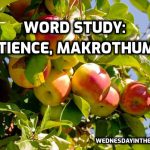Tools and resources you need to do a word study on the Greek word for patience, makrothumia, G3115.
August 2023 Reflections
WitW: Galatians started and we’ve already finished chapter 1.
03 Galatians 1:11-24 A Message from God
Paul argues he received his gospel first-hand as a revelation from the risen Lord. His lack of contact with the other apostles proves the divine origin of his understanding.
joy, chara G5479
Tools and resources you need to do a word study on the Greek word for joy, chara, G5479.
Resources for Women’s Ministry Leaders
Here are a few of my favorite ideas, tips, tricks and books from 20 years as a Director of Women’s Ministry.
02 Galatians 1:1-10 No Other Gospel
Paul opens his letter by defending his authority and his gospel. He argues you can recognize the true gospel by its source and its substance.
tutor, paidagógos, G3807
Tools and resources you need to do a word study on the Greek word for tutor, paidagógos, G3807.
Example Forms: First Day Sign up
The first day of Bible study typically requires a lot of teamwork and cooperation. You probably need leaders to sign up for both refreshments and tasks. Here’s two example sign up forms.
01 Galatians Introduction
Paul wrote this letter around 49 AD, about 15 years after the death and resurrection of Jesus to churches he founded during his first missionary journey. After Paul left, the Judaizers began teaching the Galatians they must keep the law to be fully Christian. Paul wrote this letter in response.
flesh, sarx, G4561
Tools and resources you need to do a word study on the Biblical Greek noun: flesh, sarx, G4561.
Making the most of registration forms
Registration is a chance to collect valuable information about your participants that can help you build small groups, evaluate the success of your program and plan for the future. Here are some questions you might want to include on your registration forms.
Who were the Judaizers?
The Judaizers claimed to believe in Jesus as the Jewish Messiah but insisted followers of Jesus cannot be saved unless they also kept the Mosaic law.












